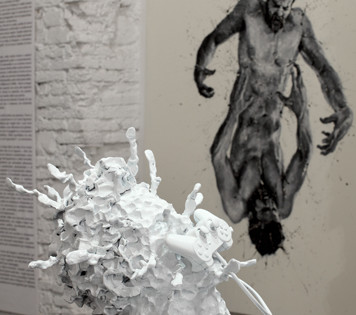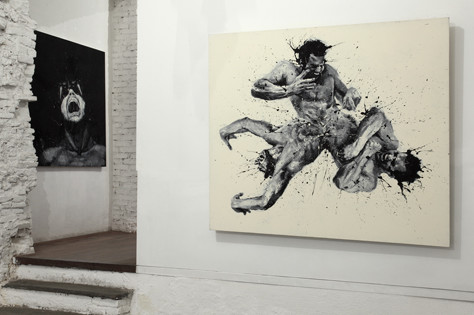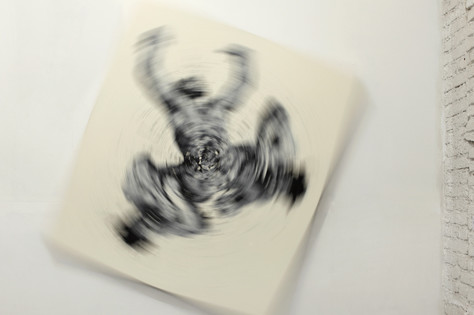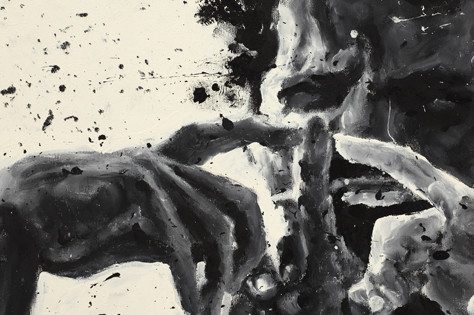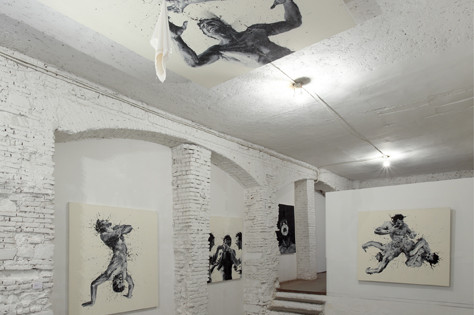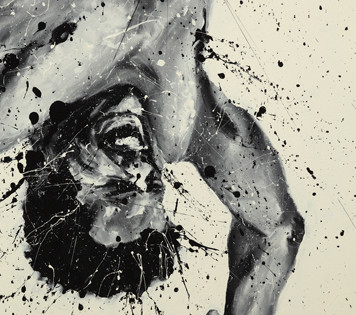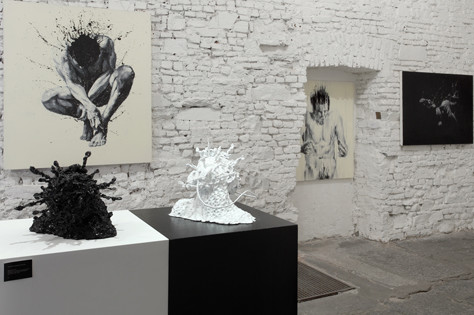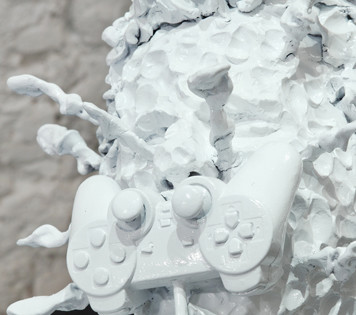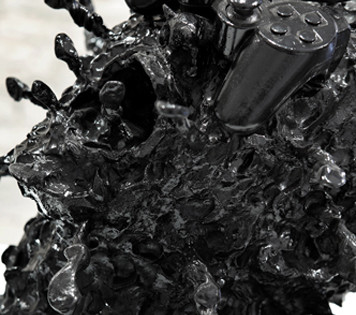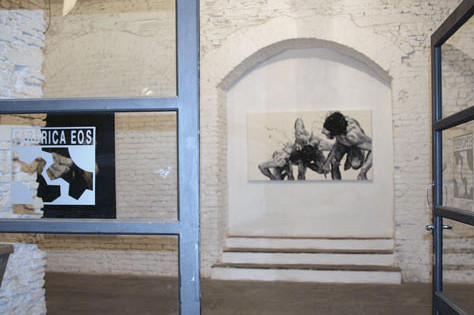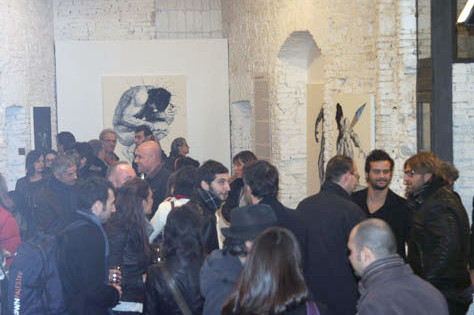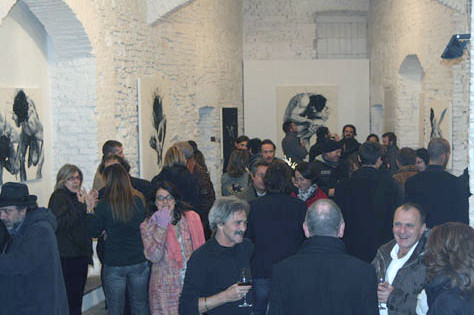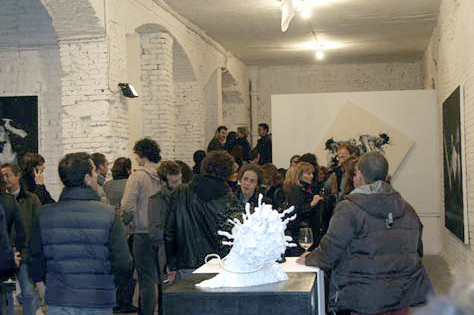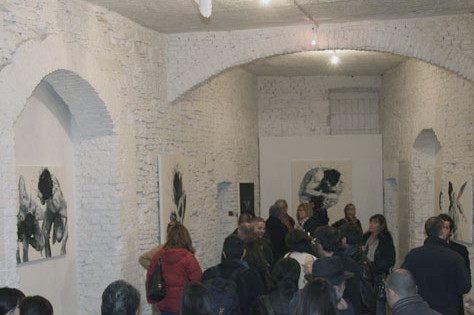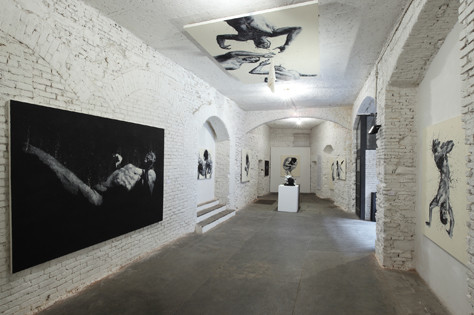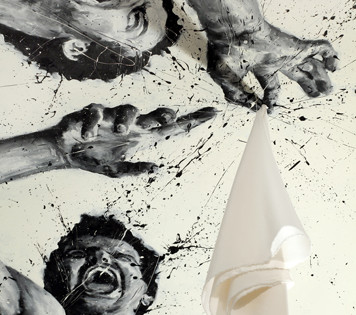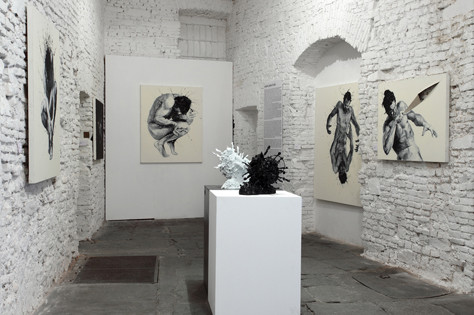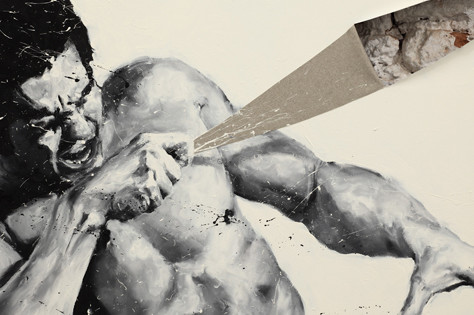TROILO Essere Paolo Troilo
Celebrity, hedonism, narcissism - today it is easier and easier to bask in the exaltation of the ego thanks to the proliferation of instruments that incite self-celebration. Instantaneous and digital photos and self-made videos could not suffice: such a quantity of material required a showcase where they could be displayed. Then the various social-networks appeared, from MySpace to LinkedIn, to the ever popular Facebook and so forth, where we can construct unnatural self-portraits as we please. With several, plenty, too many possible variations. Pirandello would have been ecstatic, as if to spite the long nose that devastates the psyche of one of his most successful characters in the miserable looking glass of his personal dresser. Identity crises, if they can still be called so, are the stuff of the past century. Each identity can be modified and moulded in the global universe that is social only in a virtual sense: Photoshop addicts speaking with the words of others, while notions and citations are distorted and rejected. Rag mag star worship is now of little value and readily attained. The confrontation of Pirandello, in which the uniqueness of the individual was actually revealed to be a multitude of variations of the same subject, is no longer the icon of a truth that is up for debate. Mirrors today are built according to a concept, only to be roughly hewn by the same protagonist who will be looking into it. They are obviously made to measure, already deformed, always beautifying. We can personally tailor our own image to suit ourselves. Because the truth - the flesh and blood truth –can shift on terribly moulded and moulding planes of virtual reality.
Portraits, as we were saying, or better yet, the “profiles” multiply beyond control. At least aesthetic ones do. We could not be further from the critical and analytical introspection of the beloved and detested self-portraits of artists of all times. There is none of Gauguin’s madness, nor the feverish restlessness of Bacon. Today those “profiles” manifest the new turn-of-the-century disease: bargain-bin celebrity and star-worship.
If only we could enter our minds, even if for just one second, and see ourselves as if we were looking through a video camera lens, recording gestures and behaviours, the fine line between sanity and schizophrenia would soon be crossed. We would step into a universe with no veils, no fictitious “profile” to save us, only the direct filming of our person. The theme, which is certainly dramatic if observed seriously, is dealt with in the form of a tragicomedy by director Spike Jonze; at the beginning of his film-making career he sets out to tell a symbolic and off-beat tale about the cult of individuality, about multiple personalities, and on the loss of one's own identity. Being John Malkovich (1999) – the title and slogan of the film – is a provocative experience. Above all when it is not other aspiring disillusioned individuals to enter the mind of the actor for 15 minutes of fame, but rather when the protagonist himself chooses to be sucked into the labyrinth of his own psyche. Thanks to a psychological short circuit, the perception of the world becomes the nightmare of a reality cloned on the same image, no longer with one or none, but with one hundred thousand Malkovich’s so that it becomes impossible to recognise which is the original.
Paolo Troilo risks the same voyage within the confines of his own person. He returns to astonish us, without the use of special effects, using large canvases on which the only figure is his self-portrait. He returns and is doubled. For lack of a better word, we can say he multiplies himself. His repeated clones interpret the challenge, individual but extendable to a more global reflection, oriented towards the investigation of relations that exist between the subjective ego and the social and interpersonal mechanisms of collective identification. Routine challenges between two or more players, among whom the roles – who is the referee and who is the player? – are deliberately blurred.
Seeking the outburst of gestures, the cry of anger, the physical outpouring of a body that strives to separate itself from its Mister Hyde is the other side of a young man – as well as an artist – who has professionally constructed himself as an art director and publicist, where we know a universe founded on the laws of appearance and formality is enforced. After having dedicated years to finding the right ingredients to enthral through mass-media subterfuge – with award-winning advertising campaigns of remarkable creative value – Paolo Troilo has exploded with screaming expressivity. His painting, dense and primordial, physical and powerful, is the inevitable answer that prevents him from succumbing to a standardising conformism. Painting as medium.
In the constancy of one's own ego reproduced without censure, the artist’s stage is set. Troilo against Troilo. A game of mirrors, or better yet, a refraction that is always equal but decomposed – into minimal variations of behaviours and postures – of the same subject. His body, repeated sometimes on a vertical axis and sometimes on a horizontal axis, blends with other forms, like those known in psychometrics as “Rorschach Ink Blots”: reflections of single-tone fields, within the extension of which we can discern content that is sometimes human, sometimes natural, or sometimes abstract. It is the co-habitation of multiple personalities inside the same container. Of course, a mere container, because the meaning is to be understood within the unresolved conflict between titans incapable of relating to each other. We sense the presence of the Nietzschian superman, deprived of his reassuring certainties; we are aware of the urge to recognise ourselves fighting tooth and nail, where survival may also mean suffering, and in any case struggling, calling upon an animality that is more and more frequently repressed.
Paolo Troilo enters the intricacies of a vision that does not accept the cloning of the individual, that challenges the virtual through the survival of a real gesture.
This is not self-celebration studied at the drawing board with stereotyped tools. For Troilo, the digital snapshot is a preparatory sketch for more complex compositions.
No matter which direction we choose to look at these works, the theme of the double and of identity, here expressly displayed in concrete figures, is the leitmotiv of an unresolved obsession.
The “multiples of Troilo” leave no respite. Neither to the viewer nor the artist who chose art as the sole means for conveying his message.
We are faced with a painting, in the strictest sense of the word, where technique – having banned brushes, with only hands leaving spots of colour directly on the canvas – is already a tale in itself. The picture, as we said, as medium: the self-portrait returns and acquires the merit that art has ontologically afforded it over the ages. This is not fiction. It is dealing with a film, this time real, summarised in the question of what “Being Paolo Troilo” means for this artist.
_______________________________________________________________________
Essere Paolo Troilo
Testo di Luca Beatrice
Celebrità, edonismo, narcisismo, oggi è sempre più facile crogiolarsi nell’esaltazione dell’io grazie alla proliferazione di strumenti che incitano l’autocelebrazione. Non bastavano fotografie digitali, istantanee, video self-made: a tanto materiale serviva una vetrina per mettersi in mostra. Ecco allora comparire i vari social-network, da Myspace a Linkedln, il più popolare Facebook e via dicendo, dove costruire a piacimento l’autoritratto innaturale di se stessi. Molte, tante, troppe le possibili varianti. Pirandello ne resterebbe estasiato, alla faccia di un naso pendulo che nel misero specchio di una toeletta personale fa crollare la psicologia del suo personaggio sicuramente più riuscito. Le crisi identitarie, se ancora possono chiamarsi tali, sono cosa di altro secolo. Oggi l’identità è mutabile e plasmabile, nell’universo globale, e solo virtualmente sociale: ci si dopa di Photoshop e si parla con parole di altri, si rigetta, snaturandole, nozioni e citazioni. Il divismo da rotocalco è cosa ormai di poco conto, a portata di mano. L’affronto di Pirandello, nel quale l’unicità della persona si rivelava in realtà essere una moltitudine di varianti dello stesso soggetto, non è più icona di una verità che si lascia mettere in discussione. Gli specchi in cui guardarci oggi si costruiscono a tavolino, sono realizzati grossolanamente dallo stesso protagonista che vi si specchierà. Sono fatti su misura, già deformati, sempre abbellenti, ovviamente. Possiamo essere noi i sarti della nostra immagine. Perché la verità, quella di carne e ossa, può traslare su piani di realtà virtuali terribilmente conformati e conformanti.
I ritratti, dicevamo, o meglio i “profili” si moltiplicano senza regole. Quelle estetiche per lo meno. Siamo ben lontani dall’introspezione critica e analitica degli autoritratti amati e odiati dagli artisti di tutti i tempi. Non c’è la follia di Gauguin, e nemmeno l’irrequietezza malata di Bacon. Oggi in quei “profili” c’è la nuova malattia di inizio secolo. Celebrità e divismo da quattro soldi.
Se potessimo entrare, anche solo per un secondo, nella nostra mente e vederci come attraverso l’obbiettivo di una telecamera, registrando gesti e comportamenti, l’orlo della schizofrenia sarebbe presto valicato. Si entrerebbe in un universo senza veli, nessun fittizio “profilo” a preservarci, solo la ripresa diretta della nostra persona. Il tema, certo drammatico se osservato in modo serioso, è affrontato in forma di una tragicommedia dal regista Spike Jonze; all’esordio della sua carriera cinematografica, tenta un racconto simbolico e buffo sul culto dell’individualità, sulle multi personalità, e sulla perdita della proprio identità. Essere John Malkovich (1999) – titolo e slogan nel film - è un’esperienza conturbante. Soprattutto quando non sono altri aspiranti disillusi a entrare nella mente dell’attore per 15 minuti di celebrità, ma quando è lo stesso protagonista a farsi auto risucchiare nel dedalo della sua psiche. Per un cortocircuito psicologico, la percezione del mondo diventa l’incubo di una realtà clonata sulla stessa immagine, con non più uno o nessuno, ma centomila Malkovich da non saperne più riconoscere l’originale.
Paolo Troilo arrischia lo stesso viaggio dentro i confini della sua persona. Torna a stupirci, senza l’uso di effetti speciali, utilizzando grandi tele in cui l’unico figurante è il suo autoritratto. Torna e si raddoppia. Si moltiplica per meglio dire. I suoi cloni reiterati interpretano la sfida, individuale ma estendibile a una riflessione più globale, che volge all’indagine delle relazioni che intercorrono tra l’io soggettivo e i meccanismi sociali e interpersonali di immedesimazione collettiva. Sfide quotidiane tra due o più giocatori, entro le quali i ruoli - che è l’arbitro e chi il giocatore? – si confondono volutamente.
Cercare l’esplosione dei gesti, il grido di rabbia, lo sfogo fisico, brutale, di un corpo che prova a separarsi dal suo mister Hyde è l’altro lato di un ragazzo – oltre che di un artista – costruitosi professionalmente come art director e pubblicitario, dove sappiamo vigere un universo fondante sulle leggi dell’apparenza e della formalità. Dopo aver dedicato anni a trovare i giusti ingredienti per ammaliare attraverso escamotage massmediatici – con campagne pubblicitarie pluripremiate e di riconoscibile valore creativo – Paolo Troilo è scoppiato in un’espressività urlante. La sua pittura, corposa e primordiale, fisica e potente, è l’inevitabile risposta per non soccombere in un omologante conformismo. La pittura è medium.
Nella costanza del proprio io riprodotto senza censure, si mette in scena il teatro dall’artista. Troilo contro Troilo. Un gioco di specchi, o meglio, una rifrazione sempre uguale eppure scomposta – in variazioni minime di atteggiamenti e posture - dello stesso soggetto. Il suo corpo, ripetuto sull’asse ora verticale ora orizzontale, si fonde in forme altre, come quelle che in psicometria sono le ben note “macchie di Rorschach”: riflessioni di monocromie espanse nella cui estensione intravedere un contenuto ora umano, naturale o astratto. È la convivenza di multipersonalità all’interno dello stesso contenitore. Beninteso, solo contenitore, perché il senso è da intuirsi nella lotta irrisolta tra titani incapaci di relazionarsi. Si respira l’aria dal superuomo nietzschiano, privato delle sue comode certezze; si avverte l’urgenza di riconoscersi in un combattimento, con unghie e denti ben in vista dove sopravvivere può voler dire anche soffrire, sicuramente lottare, chiamando in causa una sempre più spesso repressa animalità.
Paolo Troilo entra nei meandri di una visionarietà che non accetta la clonazione dell’individuo, che sfida il virtuale attraverso la sopravvivenza di un gesto reale.
Non è l’autocelebrazione studiata a tavolino con strumenti stereotipati. Lo scatto fotografico digitale è per Troilo schizzo preparatorio per composizioni più complesse.
Da qualsiasi direzione lo si voglia guardare, il tema del doppio e dell’identità, qui dichiaratamente esposto in figurazioni concrete, è il leit motiv di un ossessione irrisolta.
I “multipli di Troilo” non lasciano tregua. Non a chi li guarda, non all’artista che ha scelto l’arte come unico strumento per veicolare il suo messaggio.
Siamo di fronte a una pittura, in senso stretto, dove la tecnica - banditi i pennelli, sono le mani a imprimere direttamente macchie di colore sulla tela – è già racconto di per sé. La pittura, dicevamo, è medium: l’autoritratto torna e acquista il merito che ontologicamente l’arte gli ha consegnato nei secoli. Non è finzione. È l’affronto di un film, questa volta reale, riassunto nella questione di cosa significhi per l’artista “Essere Paolo Troilo”.
Portraits, as we were saying, or better yet, the “profiles” multiply beyond control. At least aesthetic ones do. We could not be further from the critical and analytical introspection of the beloved and detested self-portraits of artists of all times. There is none of Gauguin’s madness, nor the feverish restlessness of Bacon. Today those “profiles” manifest the new turn-of-the-century disease: bargain-bin celebrity and star-worship.
If only we could enter our minds, even if for just one second, and see ourselves as if we were looking through a video camera lens, recording gestures and behaviours, the fine line between sanity and schizophrenia would soon be crossed. We would step into a universe with no veils, no fictitious “profile” to save us, only the direct filming of our person. The theme, which is certainly dramatic if observed seriously, is dealt with in the form of a tragicomedy by director Spike Jonze; at the beginning of his film-making career he sets out to tell a symbolic and off-beat tale about the cult of individuality, about multiple personalities, and on the loss of one's own identity. Being John Malkovich (1999) – the title and slogan of the film – is a provocative experience. Above all when it is not other aspiring disillusioned individuals to enter the mind of the actor for 15 minutes of fame, but rather when the protagonist himself chooses to be sucked into the labyrinth of his own psyche. Thanks to a psychological short circuit, the perception of the world becomes the nightmare of a reality cloned on the same image, no longer with one or none, but with one hundred thousand Malkovich’s so that it becomes impossible to recognise which is the original.
Paolo Troilo risks the same voyage within the confines of his own person. He returns to astonish us, without the use of special effects, using large canvases on which the only figure is his self-portrait. He returns and is doubled. For lack of a better word, we can say he multiplies himself. His repeated clones interpret the challenge, individual but extendable to a more global reflection, oriented towards the investigation of relations that exist between the subjective ego and the social and interpersonal mechanisms of collective identification. Routine challenges between two or more players, among whom the roles – who is the referee and who is the player? – are deliberately blurred.
Seeking the outburst of gestures, the cry of anger, the physical outpouring of a body that strives to separate itself from its Mister Hyde is the other side of a young man – as well as an artist – who has professionally constructed himself as an art director and publicist, where we know a universe founded on the laws of appearance and formality is enforced. After having dedicated years to finding the right ingredients to enthral through mass-media subterfuge – with award-winning advertising campaigns of remarkable creative value – Paolo Troilo has exploded with screaming expressivity. His painting, dense and primordial, physical and powerful, is the inevitable answer that prevents him from succumbing to a standardising conformism. Painting as medium.
In the constancy of one's own ego reproduced without censure, the artist’s stage is set. Troilo against Troilo. A game of mirrors, or better yet, a refraction that is always equal but decomposed – into minimal variations of behaviours and postures – of the same subject. His body, repeated sometimes on a vertical axis and sometimes on a horizontal axis, blends with other forms, like those known in psychometrics as “Rorschach Ink Blots”: reflections of single-tone fields, within the extension of which we can discern content that is sometimes human, sometimes natural, or sometimes abstract. It is the co-habitation of multiple personalities inside the same container. Of course, a mere container, because the meaning is to be understood within the unresolved conflict between titans incapable of relating to each other. We sense the presence of the Nietzschian superman, deprived of his reassuring certainties; we are aware of the urge to recognise ourselves fighting tooth and nail, where survival may also mean suffering, and in any case struggling, calling upon an animality that is more and more frequently repressed.
Paolo Troilo enters the intricacies of a vision that does not accept the cloning of the individual, that challenges the virtual through the survival of a real gesture.
This is not self-celebration studied at the drawing board with stereotyped tools. For Troilo, the digital snapshot is a preparatory sketch for more complex compositions.
No matter which direction we choose to look at these works, the theme of the double and of identity, here expressly displayed in concrete figures, is the leitmotiv of an unresolved obsession.
The “multiples of Troilo” leave no respite. Neither to the viewer nor the artist who chose art as the sole means for conveying his message.
We are faced with a painting, in the strictest sense of the word, where technique – having banned brushes, with only hands leaving spots of colour directly on the canvas – is already a tale in itself. The picture, as we said, as medium: the self-portrait returns and acquires the merit that art has ontologically afforded it over the ages. This is not fiction. It is dealing with a film, this time real, summarised in the question of what “Being Paolo Troilo” means for this artist.
_______________________________________________________________________
Essere Paolo Troilo
Testo di Luca Beatrice
Celebrità, edonismo, narcisismo, oggi è sempre più facile crogiolarsi nell’esaltazione dell’io grazie alla proliferazione di strumenti che incitano l’autocelebrazione. Non bastavano fotografie digitali, istantanee, video self-made: a tanto materiale serviva una vetrina per mettersi in mostra. Ecco allora comparire i vari social-network, da Myspace a Linkedln, il più popolare Facebook e via dicendo, dove costruire a piacimento l’autoritratto innaturale di se stessi. Molte, tante, troppe le possibili varianti. Pirandello ne resterebbe estasiato, alla faccia di un naso pendulo che nel misero specchio di una toeletta personale fa crollare la psicologia del suo personaggio sicuramente più riuscito. Le crisi identitarie, se ancora possono chiamarsi tali, sono cosa di altro secolo. Oggi l’identità è mutabile e plasmabile, nell’universo globale, e solo virtualmente sociale: ci si dopa di Photoshop e si parla con parole di altri, si rigetta, snaturandole, nozioni e citazioni. Il divismo da rotocalco è cosa ormai di poco conto, a portata di mano. L’affronto di Pirandello, nel quale l’unicità della persona si rivelava in realtà essere una moltitudine di varianti dello stesso soggetto, non è più icona di una verità che si lascia mettere in discussione. Gli specchi in cui guardarci oggi si costruiscono a tavolino, sono realizzati grossolanamente dallo stesso protagonista che vi si specchierà. Sono fatti su misura, già deformati, sempre abbellenti, ovviamente. Possiamo essere noi i sarti della nostra immagine. Perché la verità, quella di carne e ossa, può traslare su piani di realtà virtuali terribilmente conformati e conformanti.
I ritratti, dicevamo, o meglio i “profili” si moltiplicano senza regole. Quelle estetiche per lo meno. Siamo ben lontani dall’introspezione critica e analitica degli autoritratti amati e odiati dagli artisti di tutti i tempi. Non c’è la follia di Gauguin, e nemmeno l’irrequietezza malata di Bacon. Oggi in quei “profili” c’è la nuova malattia di inizio secolo. Celebrità e divismo da quattro soldi.
Se potessimo entrare, anche solo per un secondo, nella nostra mente e vederci come attraverso l’obbiettivo di una telecamera, registrando gesti e comportamenti, l’orlo della schizofrenia sarebbe presto valicato. Si entrerebbe in un universo senza veli, nessun fittizio “profilo” a preservarci, solo la ripresa diretta della nostra persona. Il tema, certo drammatico se osservato in modo serioso, è affrontato in forma di una tragicommedia dal regista Spike Jonze; all’esordio della sua carriera cinematografica, tenta un racconto simbolico e buffo sul culto dell’individualità, sulle multi personalità, e sulla perdita della proprio identità. Essere John Malkovich (1999) – titolo e slogan nel film - è un’esperienza conturbante. Soprattutto quando non sono altri aspiranti disillusi a entrare nella mente dell’attore per 15 minuti di celebrità, ma quando è lo stesso protagonista a farsi auto risucchiare nel dedalo della sua psiche. Per un cortocircuito psicologico, la percezione del mondo diventa l’incubo di una realtà clonata sulla stessa immagine, con non più uno o nessuno, ma centomila Malkovich da non saperne più riconoscere l’originale.
Paolo Troilo arrischia lo stesso viaggio dentro i confini della sua persona. Torna a stupirci, senza l’uso di effetti speciali, utilizzando grandi tele in cui l’unico figurante è il suo autoritratto. Torna e si raddoppia. Si moltiplica per meglio dire. I suoi cloni reiterati interpretano la sfida, individuale ma estendibile a una riflessione più globale, che volge all’indagine delle relazioni che intercorrono tra l’io soggettivo e i meccanismi sociali e interpersonali di immedesimazione collettiva. Sfide quotidiane tra due o più giocatori, entro le quali i ruoli - che è l’arbitro e chi il giocatore? – si confondono volutamente.
Cercare l’esplosione dei gesti, il grido di rabbia, lo sfogo fisico, brutale, di un corpo che prova a separarsi dal suo mister Hyde è l’altro lato di un ragazzo – oltre che di un artista – costruitosi professionalmente come art director e pubblicitario, dove sappiamo vigere un universo fondante sulle leggi dell’apparenza e della formalità. Dopo aver dedicato anni a trovare i giusti ingredienti per ammaliare attraverso escamotage massmediatici – con campagne pubblicitarie pluripremiate e di riconoscibile valore creativo – Paolo Troilo è scoppiato in un’espressività urlante. La sua pittura, corposa e primordiale, fisica e potente, è l’inevitabile risposta per non soccombere in un omologante conformismo. La pittura è medium.
Nella costanza del proprio io riprodotto senza censure, si mette in scena il teatro dall’artista. Troilo contro Troilo. Un gioco di specchi, o meglio, una rifrazione sempre uguale eppure scomposta – in variazioni minime di atteggiamenti e posture - dello stesso soggetto. Il suo corpo, ripetuto sull’asse ora verticale ora orizzontale, si fonde in forme altre, come quelle che in psicometria sono le ben note “macchie di Rorschach”: riflessioni di monocromie espanse nella cui estensione intravedere un contenuto ora umano, naturale o astratto. È la convivenza di multipersonalità all’interno dello stesso contenitore. Beninteso, solo contenitore, perché il senso è da intuirsi nella lotta irrisolta tra titani incapaci di relazionarsi. Si respira l’aria dal superuomo nietzschiano, privato delle sue comode certezze; si avverte l’urgenza di riconoscersi in un combattimento, con unghie e denti ben in vista dove sopravvivere può voler dire anche soffrire, sicuramente lottare, chiamando in causa una sempre più spesso repressa animalità.
Paolo Troilo entra nei meandri di una visionarietà che non accetta la clonazione dell’individuo, che sfida il virtuale attraverso la sopravvivenza di un gesto reale.
Non è l’autocelebrazione studiata a tavolino con strumenti stereotipati. Lo scatto fotografico digitale è per Troilo schizzo preparatorio per composizioni più complesse.
Da qualsiasi direzione lo si voglia guardare, il tema del doppio e dell’identità, qui dichiaratamente esposto in figurazioni concrete, è il leit motiv di un ossessione irrisolta.
I “multipli di Troilo” non lasciano tregua. Non a chi li guarda, non all’artista che ha scelto l’arte come unico strumento per veicolare il suo messaggio.
Siamo di fronte a una pittura, in senso stretto, dove la tecnica - banditi i pennelli, sono le mani a imprimere direttamente macchie di colore sulla tela – è già racconto di per sé. La pittura, dicevamo, è medium: l’autoritratto torna e acquista il merito che ontologicamente l’arte gli ha consegnato nei secoli. Non è finzione. È l’affronto di un film, questa volta reale, riassunto nella questione di cosa significhi per l’artista “Essere Paolo Troilo”.

